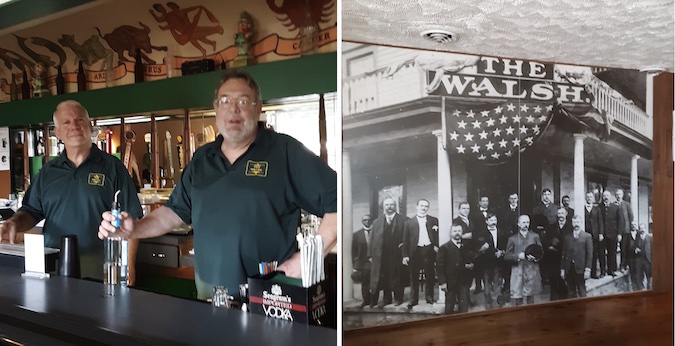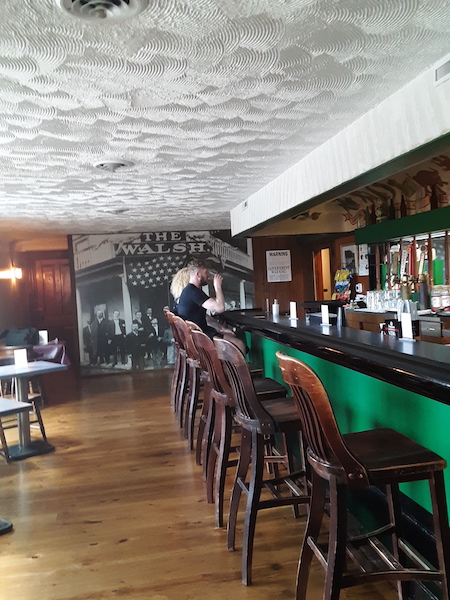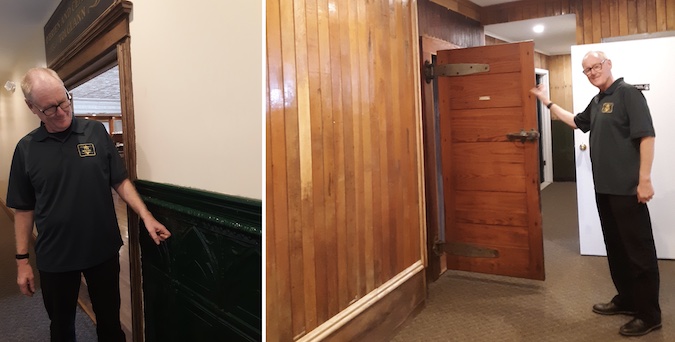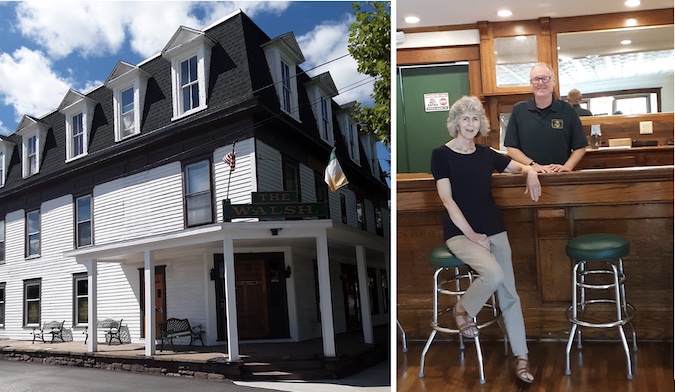The Walsh, historic bar in Medina, reopens after 3 years of renovation
Tim Cooper gives new life to landmark on West Avenue
MEDINA – A historic landmark in Medina has reopened under new ownership, after three years of renovation.
Tim Cooper, a local funeral director, has an interest in older buildings with architectural style or appeal, sites that have been neglected and on the verge of being lost.
“The Walsh Hotel fit all those criteria,” said Cooper, who purchased the Walsh Hotel in March 2019. Cooper was operating Cooper Funeral Home on West Center Street with his assistant Jake Hebdon. On Dec. 29, 2018, Hebdon took over and three months later Cooper negotiated with Guy Chiarolanza to purchase the Walsh.
“I had looked at it in December 2018 when Polar Express was running at the Medina Railroad Museum,” Cooper said. “There were a lot of people and I thought this presented an opportunity. I like to retore old buildings to modern use and living, while incorporating the historic design details that made them distinctive.”

Bartenders David Minervino, left, and Marc Law stand behind the bar at the newly opened Walsh Hotel. (Right) This mural at the end of the Walsh Hotel’s bar shows Democratic candidate Francis Burton Harrison, center (holding his hat) when he campaigned in Medina for lieutenant governor in 1904.
Cooper has restored five other properties in Medina: 105 Pearl St., 215 West Center St., 212 Park Ave., 213 Park Ave. and 1024 West Ave.
“I put a lot of sweat equity and investment into the Walsh, with the able assistance of Denny More, and it is now ready to be a unique bar/restaurant/hotel venue,” Cooper said.
History of the Walsh Hotel goes back to 1852 when the Rochester, Lockport and Niagara Falls Company completed the railroad through Medina. Previously, hotels and taverns in Medina sprung up adjacent to the canal basin, but the development of the railroad had an immediate effect on the Erie Canal. Soon, the New York Central Railroad Company was the primary transportation provider.
The first depot was a small stone building close to the railroad on West Avenue, and the adjacent lot on the west side of the street was the obvious site for a hotel, a waiting and meeting place for travelers, particularly since the depot provided sparse comfort.
Aaron Clark (who also built the Alabama Hotel) was granted a license for the Clark Hotel in 1861. The third floor was put on, doubling the size of the building. It was sold to Frank Sloat in 1884 and later to Thomas Lysett. Eugene Walsh purchased it in 1903 and renovated and enlarged it with 38 rooms.

Several customers enjoy a drink at the bar in the newly reopened Walsh Hotel.
In 1904, Francis Burton Harrison, Democratic candidate for lieutenant governor, arrived by train to campaign there, and then went to dinner at Bent’s Opera House. Although he didn’t win, he went on to become governor general of the Philippines.
In 1916, a New York City attorney Grace Humiston was there to champion the innocence of West Shelby resident George Stielow, who had been wrongly accused of murdering his employer. She would later prove his innocence with the use of forensics for the first time in history to solve a murder.
Other famous visitors were Babe Ruth, who stayed at the Walsh in 1920, and Adolph S. Ochs Jr., New York Times publisher, who lunched there in 1925.
An article in the Medina Tribune on June 30, 1938, reported that any man in Western New York who was asked if they knew where the Walsh Hotel was would beam with recognition, brought on by memories of “succulent steaks, broiled chicken and braised short ribs of beef, all served with steaming bowls of gravy.”
Historical accounts say Walsh “virtually built over” the hotel into one of the most up-to-date hotels between Buffalo and Rochester, with 38 cheerful sleeping rooms, each furnished with electric lights and electric call bells, steam heat and “special attention to sanitary conditions.” The hotel was frequented by commercial travelers and local businessmen and professionals lunched there on a regular basis. It was a popular venue for business meetings, bridge tournaments and dinner parties, all of which sustained it through Prohibition and Depression.
Frank Cardone bought the Walsh in 1941, and remodeled it after a fire in the barroom area in 1959. He ran it until 1977, when he conveyed it to Guy Chiarolanza. No food or beverages were sold there in recent years, and it operated strictly as a boarding house.
After his purchase, Cooper spent three years totally remodeling the downstairs, with assistance from contractor Dennis Moore and construction workers Monty Hartman and Mike Eckerd. Mark Weld created the new signage. The upstairs remains a work in progress, Cooper said. He has no plans to open a restaurant there, but does offer sandwiches from Sourced Market and Eatery.
Cooper’s renovation included gutting the barroom, adding a window for more light, moving the staircase to the outside of the building, taking out a cooler, replacing a rotted section of floor, moving a wall, putting a second bar on the north side in a dining room called the O’Brien and Ceallaigh (Irish spelling of Kelly) Tap Room. This room is available to rent for private parties and social gatherings.
He also upgraded the heating and cooling, did lots of painting, maintaining the tin ceiling and tin wainscoting, and making roofing and siding improvements on the outside.
“The Walsh is a survivor. It has character. It has survived the decline of the railroad, Prohibition, the Depression and massive social changes. It started out and thrived because of its proximity to the railroad and I think that has come full circle. There are a few more chapters in the Walsh’s history. It is still a landmark – and a feisty, enduring one.” – Tim Cooper
Cooper has hired two bartenders, whose history is entwined with each other and Cooper.
Marc Law and David Minervino both grew up in Medina and have been lifelong friends. Cooper’s older brother Jim and Marc went to school together. Marc’s grandmother was Mildred Cleary, who owned Cleary Funeral Home on Park Avenue and was instrumental in Cooper’s decision to become a funeral director.
Cooper was working on the building the day after he purchased it, when Law stopped in and offered to help if he ever got to that point.
“I did eventually get to that point,” Cooper said, and he called Law.
Law left Medina for 35 years, pursuing a career with hotels, restaurants and as a bar manager. He began tending bar in 2010 and worked in West Virginia and Southern California, before returning to Medina 10 years ago.
He likes tending bar because “It’s such a positive atmosphere, and you’re constantly meeting people,” he said.
Minervino worked at Kodak for 22 years and dealt in a casino for four years. He worked for Chiarolanza for three years in the late 1970s, and at Tillman’s Village Inn for 30 years until they closed in December 2021.
Like Law, he loves bartending because of the social activity and all the people he meets.

Tim Cooper, who has restored and reopened the Walsh Hotel, points out the original tin wainscoting on the wall of the entrance hallway. (Right) Cooper stands by a door leading into the bar area. He removed the door from a cooler which stood where he is standing. The sides of the cooler were used for the wall at left.
Cooper also has a family background in the tavern/bar business. Edward Kelly, who built O’Brien’s Pub on Main Street, was his great-grandfather. Cooper’s grandfather Francis O’Brien married Kelly’s daughter Margaret and they ran the pub as O’Brien’s and Kelly’s. Hence, Cooper’s name (O’Brien and Ceallaigh) on his tap room.
The Irish influence also includes Cooper’s wife Catherine, who is from County Kerry.
Cooper said it is an interesting fact that in old time Ireland, the pub owner in a rural area was usually the undertaker.
In restoring the Walsh, Cooper said it was his goal to create something which has been lacking in the area – the ability to go into a pub and talk.
“People who come in here actually feel refreshed,” Minervino said. “They talk to one another. There are no cell phones, no TV, just old-fashioned conversation.”
Cooper said the Walsh is ideally poised for a new chapter.
Catherine, who is Orleans County historian, in a history she wrote on the Walsh, said that although its luster may have dimmed for a time, the Walsh is still a landmark.
Tim said when he initially started the project, he had hoped the Downtown Revitalization Initiative would come through with funds for the project. However, that wasn’t the case. Medina wasn’t picked by the state for the funding, yet.
“The Walsh is a survivor,” Tim said. “It has character. It has survived the decline of the railroad, Prohibition, the Depression and massive social changes. It started out and thrived because of its proximity to the railroad and I think that has come full circle. It will benefit the Medina Railroad Museum and the Museum will benefit it. There are a few more chapters in the Walsh’s history. It is still a landmark – and a feisty, enduring one.”
The Walsh is open from 3 to 10 p.m. Thursday and 3 to 11 p.m. Friday and Saturday. It serves a full line of alcoholic drinks, including imported Dingle gin from Dingle, Ire. Their phone number for information or to reserve the O’Brien and Cealliagh Room is (585) 318-5027.






































































